Feral Cat Had Kittens: What to Do Next to Help Them Thrive
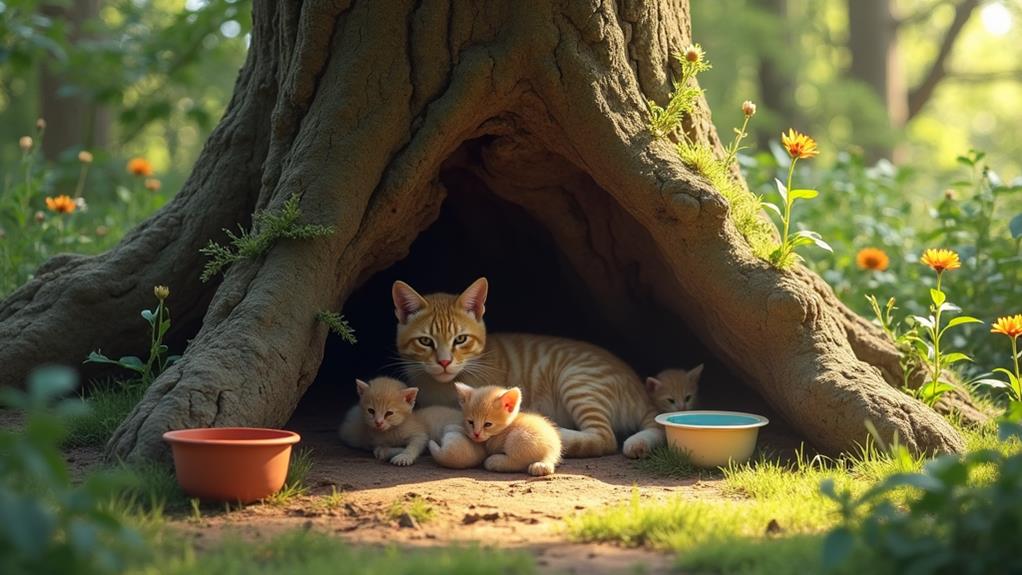
When a feral cat has kittens, start by observing from a distance to confirm the mother is present and caring for them. Provide high-quality food and water, and create a safe, quiet space to minimize stress. Monitor their health and check for any signs of illness. If the mother is absent, you'll need to provide immediate care for the kittens. Consider working with local rescues or TNR programs for long-term solutions. Understanding the kittens' developmental stages will help tailor their care effectively. There's more to investigate about keeping them safe and healthy through these formative weeks.
Assess the Situation
Observing the mother cat and her kittens from a distance is the initial step in evaluating the situation. You want to confirm the mother is present and actively caring for her kittens, as her warmth and nutrition are essential. Assess the environment to verify it's safe, steering clear of potential hazards like traffic or aggressive animals. Check that the mother has access to food and water to sustain her health and ability to care for her young.
When you assess the health of the kittens, watch closely for signs of illness or distress. If they're under eight weeks old, it's imperative they remain with their mother unless they're in immediate danger or need medical attention. Lack of weight gain, lethargy, or unusual vocalizations are red flags that require a veterinarian's attention.
Socialization is significant, but if the mother is feral and not approachable, create a safe, quiet space for her and her kittens. This environment should minimize human interaction to reduce stress. Monitor their progress, confirming they're in a nurturing setting where the mother cat can thrive, and her kittens can grow healthily under her care.
Monitor the Mother Cat
When caring for feral kittens, it's vital to keep a close eye on the mother cat's behavior. Make sure she's nurturing her kittens by licking them, keeping them warm, and providing them with milk. These actions are significant for their survival in the initial few weeks. To help her feel secure and focus on caring for her young, keep the area quiet and free from disturbances.
Monitor the mother cat's health by observing her appetite and checking for signs of illness. Look out for symptoms like poor appetite or mastitis, which manifests as swollen, painful teats and may require veterinary attention. Ensuring her health is imperative as it directly affects her ability to care for her kittens.
While she's nursing, provide high-quality kitten food and fresh water within easy reach. This supports her increased nutritional needs, helping her maintain the energy and health needed for effective nursing. Allow her to move her kittens if necessary for their safety, warmth, or hygiene. Avoid handling the kittens until they're at least two weeks old to respect her instincts. By doing this, you help create a stable environment for the mother cat and her kittens to thrive.
Determine Kittens' Age
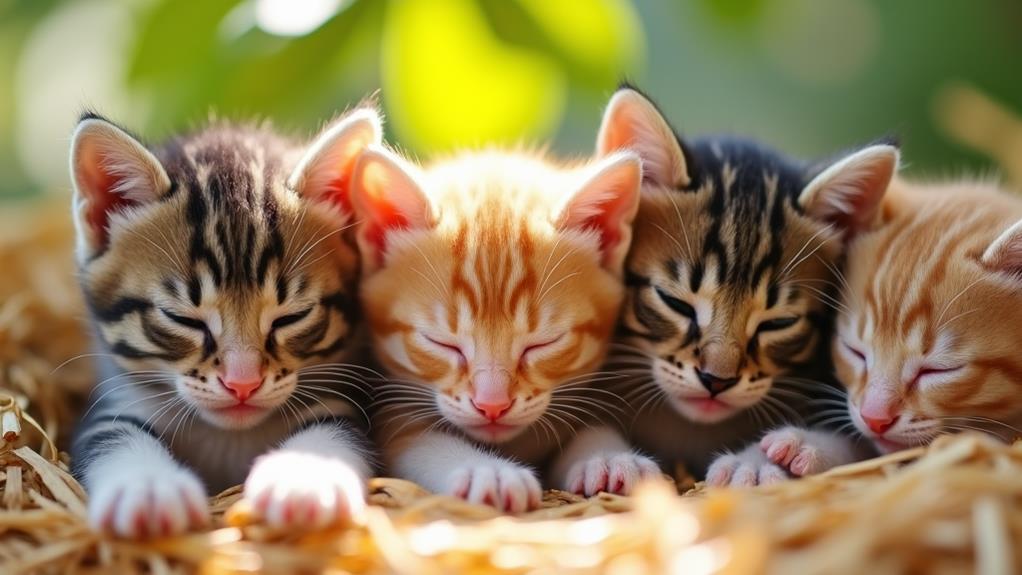
Pinpointing the stage of feral kittens is crucial for providing appropriate care and nutrition. Accurately evaluating their maturity helps you tailor feeding, socialization, and general care. Here's how you can determine their maturity:
- Under 2 Weeks: Kittens have their eyes closed, are uncoordinated, and require bottle feeding every 2-3 hours. They need 1-2 ounces of goat milk or formula per feeding.
- 2-4 Weeks: Their eyes open, they begin to play, and they still need bottle feeding every 4-6 hours. Around 3 weeks, they can start using a litter box.
- 4-6 Weeks: Kittens shift to eating wet food and drinking water. They start to investigate and socialize more in their environment, learning from their feral mother.
- 6-8 Weeks: Eating dry food becomes possible, and they can be weaned. This time is safe for potential separation from the mother if necessary.
Understanding these developmental milestones enables you to support the kittens' growth in a way that suits their specific needs. By doing so, you'll help them integrate into the community successfully. Remember, feral kittens might need extra socialization efforts, especially those over 8 weeks old, to build trust.
Decide on Intervention
Considering finding feral kittens, it's important to decide if intervention is necessary based on a few key factors. Initially, wait several hours to see if the feral cat returns. The mother cat is usually the best caregiver for her young, so don't rush to intervene unless the kittens are in immediate danger or injured. Handling them too soon can disrupt that significant mother-kitten bond.
If the mother doesn't return and the kittens are under 8 weeks old, you'll need to provide round-the-clock care, including bottle feeding every 2-4 hours with a suitable kitten formula. This level of care is demanding but essential for their survival. Alley Cat Allies offers excellent resources to guide you through this process.
For kittens over 8 weeks, assess their social behavior. If they're still without the mother cat, it's a good time to think about socialization and spaying/neutering. These steps are important to prevent overpopulation and help them adapt to a more social environment. Deciding to intervene is a significant commitment, so carefully consider these factors and use available resources to guarantee you're making the best decision for the kittens' well-being.
Provide Basic Needs
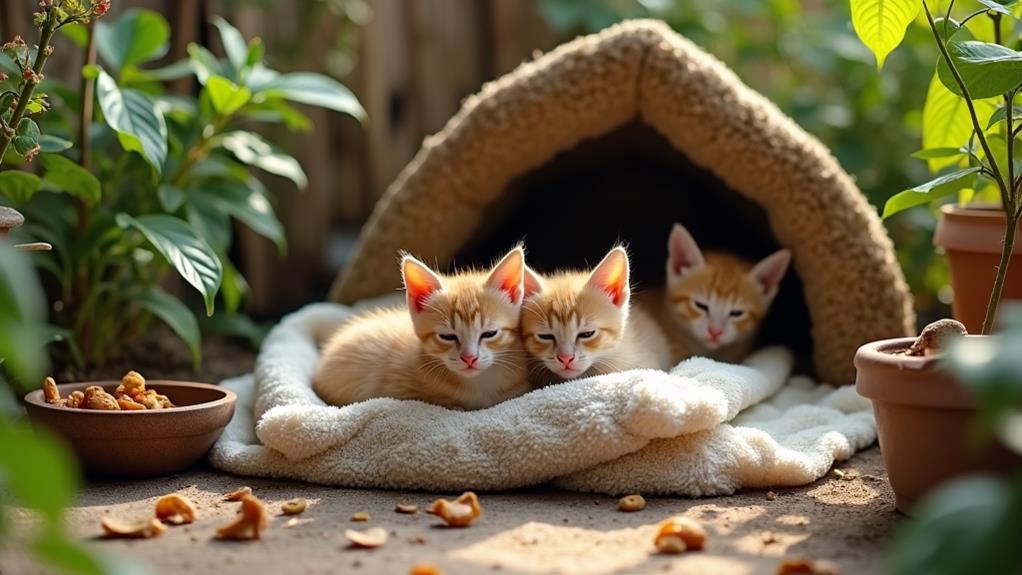
Meeting the basic needs of feral kittens and their mother is vital for their health and development. Start by providing the mother cat with high-calorie, high-protein kitten food at least three times a day. This supports her nutritional needs while she's nursing her kittens. A shallow dish of fresh water should always be available to keep her hydrated, making sure it's shallow enough to prevent any drowning hazards for the kittens.
Create a safe space for the mother and her kittens by setting up a nesting box lined with a soft blanket. This will offer comfort and security, fundamental for their well-being. It's also significant to monitor growth by weighing the kittens twice daily. This helps guarantee they're gaining weight and receiving adequate nutrition from their mother.
Maintain strict hygiene practices to prevent disease spread. Wash your hands before and after handling the mother cat and her kittens. Here's a checklist to help you provide these basic needs:
- High-calorie, high-protein food: Offer the mother cat kitten food at least thrice daily.
- Fresh water: Confirm availability in a safe, shallow dish.
- Safe space: Create a cozy nesting box.
- Monitor growth: Weigh kittens twice daily for adequate nutrition.
Consider TNR Options
When it comes to managing feral cat populations, TNR (Trap-Neuter-Return) is an effective and humane strategy. It involves trapping feral cats, having them spayed or neutered, and then returning them to their original location. This humane method is vital in preventing overpopulation by ensuring no future litters are born, thereby managing cat populations effectively.
When a feral cat has kittens, consider TNR options as soon as possible. Kittens can become pregnant as early as five months old, so timely action is important to prevent them from contributing to the overpopulation problem. By implementing TNR, you'll help stabilize the cat colonies and improve the general health and welfare of these community cats.
Many animal welfare organizations advocate for TNR due to its proven success in reducing the number of kittens born each year. Not only does it prevent overpopulation, but it also improves the behavior and health of feral cats, leading to more harmonious interactions with local residents. By choosing TNR, you're not only supporting responsible cat welfare but also playing an active role in fostering a healthier environment for both the cats and the community.
Avoid Animal Shelters
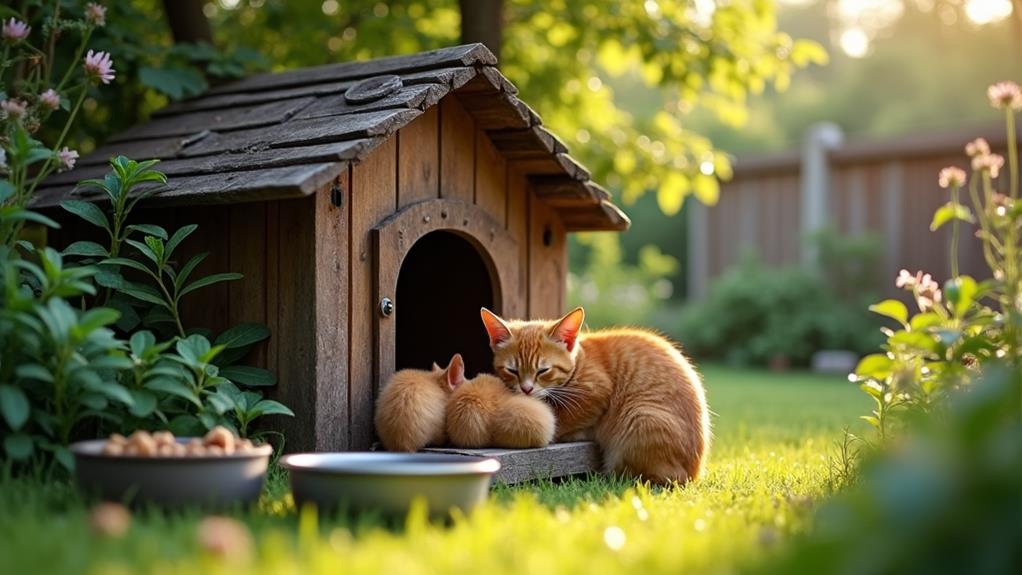
When caring for feral kittens, resist the urge to take them to an animal shelter. Most shelters are ill-equipped to handle unweaned kittens, which can put them at risk of stress, illness, or even euthanasia. The fragile immune systems of neonatal kittens make them particularly susceptible to diseases found in shelter environments. Instead of opting for a shelter, consider alternative solutions for effective kitten care.
- Nursing mother cat: If the mother cat is around, allow her to continue nursing the kittens, as her care is essential for their development.
- Alley Cat Allies: Utilize the resources and guides they provide to support neonatal kittens without involving a shelter.
- Wait Until 8® programs: Some shelters offer these, allowing you to care for the kittens until they're ready for adoption or spay/neuter.
- Good Samaritans: Reach out to friends, family, or local networks to help with kitten food and care needs.
Engage With Local Rescues
Connecting with local animal rescues can be a game changer when caring for feral kittens. Local rescues and shelters often have resources and programs designed specifically for feral cat families, providing invaluable support. By reaching out, you can investigate fostering options and adoption options for the kittens. These organizations often offer TNR services, ensuring the mother cat is spayed to prevent future litters, effectively managing the feral cat populations.
Engaging with these rescues connects you with a network of experienced advocates who can provide insights into kitten care. They can guide you on the best practices for socializing feral kittens, increasing their chances of successful rehoming. Many rescues have dedicated volunteers ready to assist with socialization and rehoming efforts, offering hands-on community support.
Supporting local rescues isn't just about seeking help; you can also contribute by donating or volunteering. Your support helps these organizations continue their essential work with feral cats and their kittens. By collaborating with local rescues, you're not only helping the kittens in your care but also strengthening the community's efforts to support feral cat families. This partnership is a significant step toward ensuring the kittens thrive.
Plan for Spay/Neuter
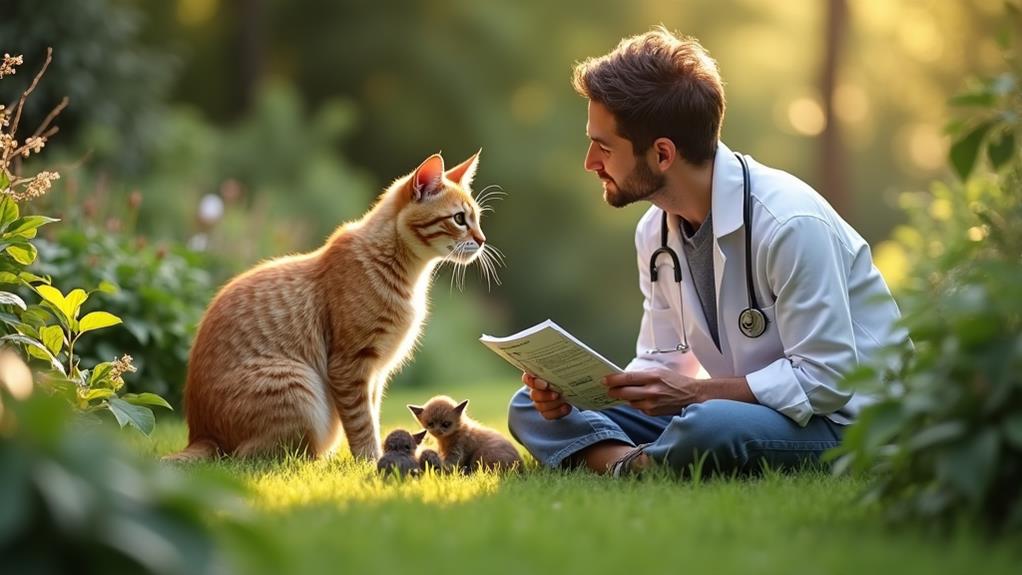
Ensuring feral cats are spayed or neutered is an important step in controlling their populations and preventing unwanted litters. Female cats can become pregnant as early as 5 months old, so acting swiftly is vital. The ideal time to spay or neuter kittens is when they're around 8 weeks old and weigh at least 2 pounds. This not only benefits their health but also helps manage the feral cat population.
Trap-Neuter-Return (TNR) programs are highly effective in stabilizing feral cat colonies. By preventing new litters, these programs improve the health and behavior of community cats. Here's how you can get involved:
- Coordinate with local veterinarians or rescue groups: Schedule spay/neuter appointments efficiently.
- Ensure the quick return of the mother cat: After spaying, reunite her with her kittens promptly to maintain their care.
- Document your actions: Keep track of appointments and follow-ups for both the mother cat and her kittens.
- Monitor the health of the kittens: Regularly check their weight and general condition before the procedure.
Join Community Efforts
Why not take an active role in community efforts to help feral kittens thrive? Start by engaging with local community cat programs. These initiatives often focus on TNR (Trap-Neuter-Return), a significant method for managing feral cat populations and ensuring the well-being of kittens. By learning and participating in TNR efforts, you directly support feral cats and contribute to their long-term welfare.
Volunteering with or donating to local shelters and rescue groups is another impactful way to help. These organizations provide critical resources and support to feral cats and their kittens, ensuring they have a chance at survival and a better quality of life. Your involvement can make a substantial difference.
Consider attending workshops and training sessions offered by animal welfare organizations like Alley Cat Allies. They provide valuable education and skills, equipping you to effectively assist feral cats and their offspring. Participating in community outreach initiatives focused on responsible cat care and feral cat management is fundamental for raising awareness and garnering support.
Lastly, joining online forums or social media groups dedicated to cat advocacy connects you with like-minded individuals. Share experiences, gain insights, and stay informed about best practices for supporting feral cats and their kittens.




